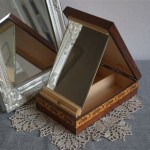Antique Japanese Hand Mirrors: A Glimpse into History and Artistry
Antique Japanese hand mirrors, known as *kagami*, offer a fascinating reflection of Japanese history, artistry, and cultural beliefs. More than just everyday objects, these meticulously crafted pieces represent a unique blend of functionality and artistic expression. Their evolution through different eras showcases the changing tastes and techniques of Japanese artisans, making them highly sought-after collectibles today.
Materials and Construction
Traditional Japanese hand mirrors were typically made of bronze, with the reflective surface created through a meticulous polishing process. Later, other metals like silver and a copper-tin alloy were also used. The back of the mirror provided a canvas for artistic decoration, often featuring intricate designs inlaid with gold, silver, and other precious metals. Occasionally, lacquer work or elaborate carvings adorned the handles, adding to their aesthetic value. The craftsmanship involved in creating these intricate designs highlights the skill and dedication of the artisans.
The Evolution of Design Through Different Eras
The designs found on antique Japanese hand mirrors evolved significantly throughout history, reflecting the prevalent artistic styles of each era. Early examples from the Kofun period (300-538 AD) are often simple and geometric. During the Heian period (794-1185), intricate patterns inspired by nature, literature, and courtly life became popular. The Edo period (1603-1868) saw a flourishing of diverse styles, ranging from depictions of landscapes and mythical creatures to scenes from popular Kabuki plays. Examining these changing motifs allows one to trace artistic and cultural shifts across centuries.
Symbolism and Cultural Significance
Beyond their practical use, hand mirrors held symbolic importance in Japanese culture. They were often associated with the sun goddess Amaterasu and considered sacred objects. Mirrors were also viewed as symbols of truth, purity, and self-reflection. Furthermore, certain designs, like cranes and tortoises, carried auspicious meanings related to longevity and good fortune. The inclusion of these symbolic elements elevates the mirror from a simple utilitarian object to a vessel of cultural and spiritual significance.
Types of Antique Japanese Hand Mirrors
Several distinct types of antique Japanese hand mirrors exist, each with unique characteristics. *Te-kagami* are small, handheld mirrors, while *kagami-dai* incorporate a stand, allowing for hands-free use. *Azuma-kagami* are characterized by their oval shape and often feature intricate lacquer work. Another type, known as *maki-e* mirrors, showcase elaborate designs created by sprinkling gold or silver powder onto wet lacquer. Understanding these different types aids in appreciating the diversity and artistry within this specific field of Japanese antiques.
Collecting and Appraising Antique Japanese Mirrors
Collecting antique Japanese hand mirrors has become a popular pursuit among enthusiasts of Asian art. Factors such as age, condition, materials, and the intricacy of the design all contribute to a mirror's value. Consulting reputable dealers and appraisers is crucial for authenticating and determining the worth of a piece. Furthermore, understanding the historical context and stylistic features associated with different periods can assist collectors in making informed decisions and building valuable collections.
Preservation and Care
Proper care and preservation are essential for maintaining the beauty and integrity of antique Japanese hand mirrors. Cleaning should be done with utmost caution, avoiding harsh chemicals or abrasive materials that could damage the delicate surface. Storing the mirrors in a stable environment, away from extreme temperature fluctuations and humidity, helps prevent deterioration. Consulting conservation professionals is recommended for handling significant damage or restoration needs. This ensures the preservation of these historical artifacts for future generations to appreciate.
The Enduring Appeal
Antique Japanese hand mirrors offer a captivating glimpse into the artistic heritage and cultural values of Japan. Their intricate designs, symbolic meanings, and historical significance continue to fascinate collectors and art enthusiasts alike. These meticulously crafted objects serve as a testament to the enduring legacy of Japanese artistry and its enduring appeal across time.

Antique Japanese Kagami Hand Mirror Pat Mcgann Gallery

Kagami Reflections Japanese Antique Hand Mirrors

Antique Japanese Kagami Hand Mirror Pat Mcgann Gallery

Antique Japanese Broe Mirror Kagami Signed Hand Held

Japanese Antique Broe Hand Mirror Shibui Antiques Furniture

Japan Antique 100 Year Old Japanese Hand Mirror Kagkimi Executed In Gilt Broe And With An Original Bamboo Wrapped Handle Signed Mint Condition 13 5 Length Schneible Fine Arts Llc

Japanese Antique Broe Hand Mirror Shibui Antiques Furniture

Antique Japanese Broe Hand Mirror W Erfly Kagami Edo Period Rare

Japanese Hand Mirror Copper Or Broe Tekami Meiji Taisho Era From Japan

Japan Antique 100 Year Old Japanese Hand Mirror Kagkimi Executed In Gilt Broe And With An Original Bamboo Wrapped Handle Signed Mint Condition 13 5 Length Schneible Fine Arts Llc








